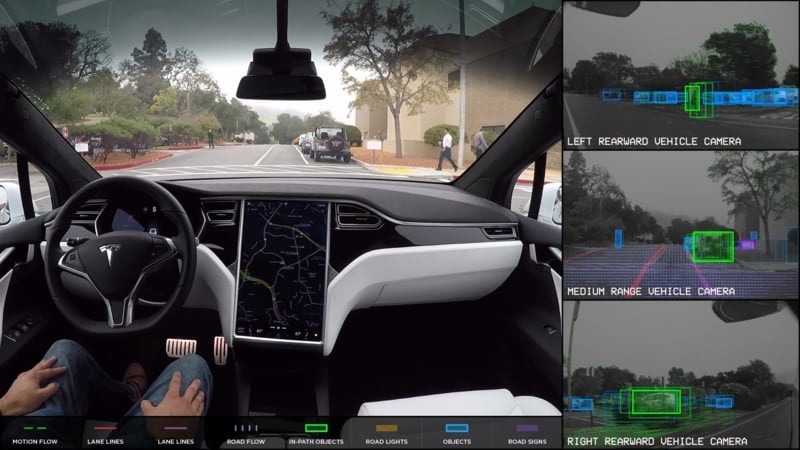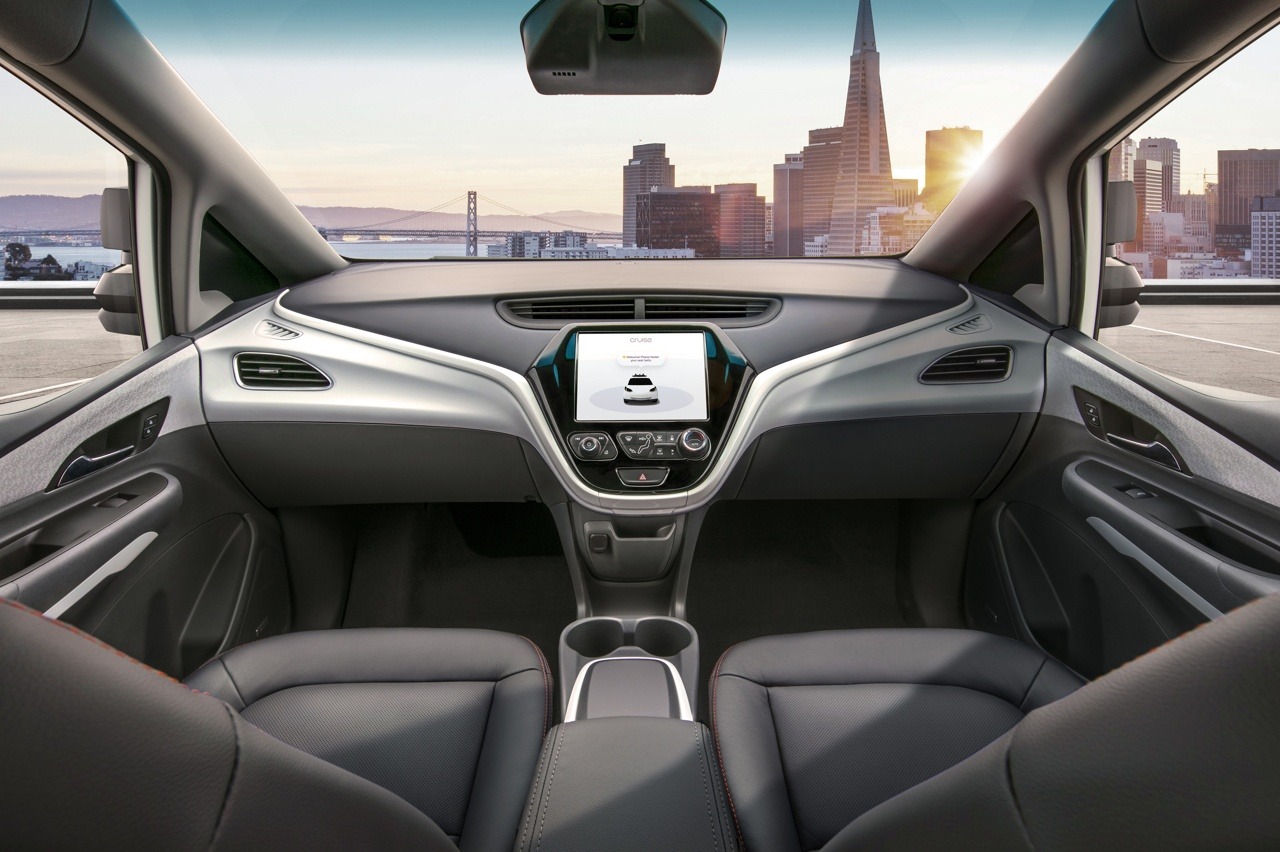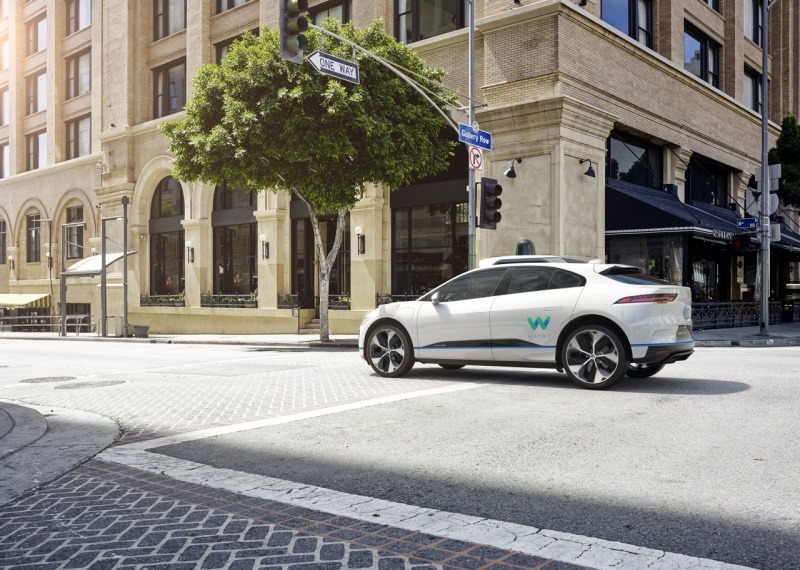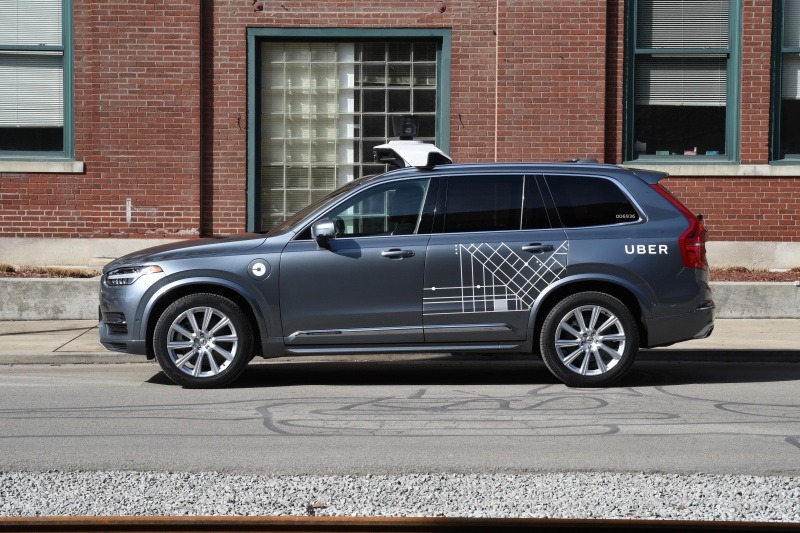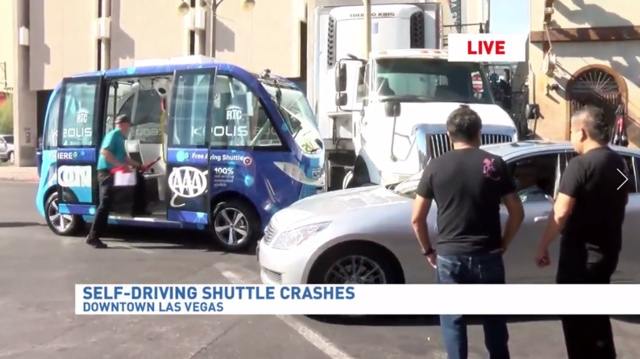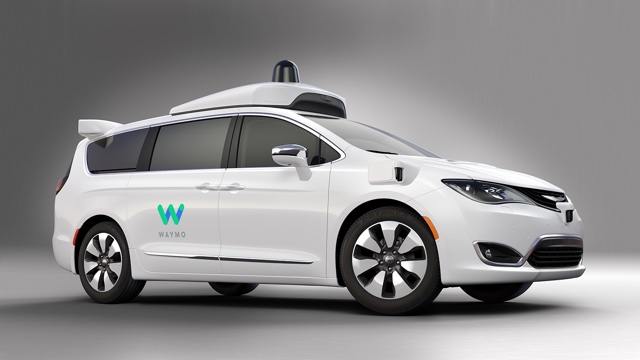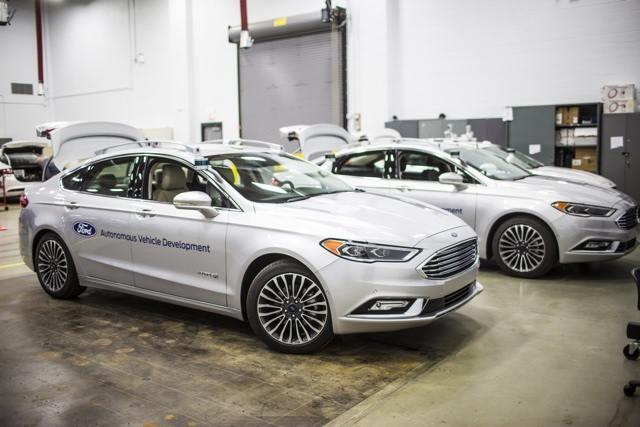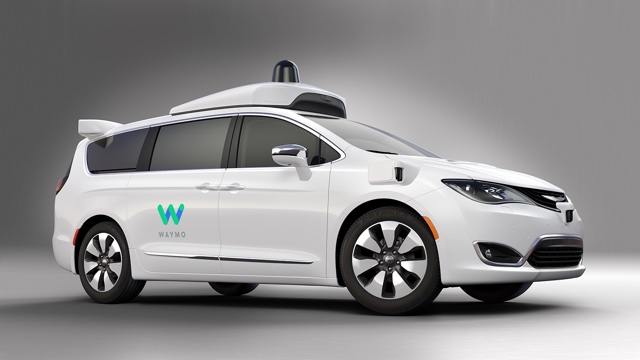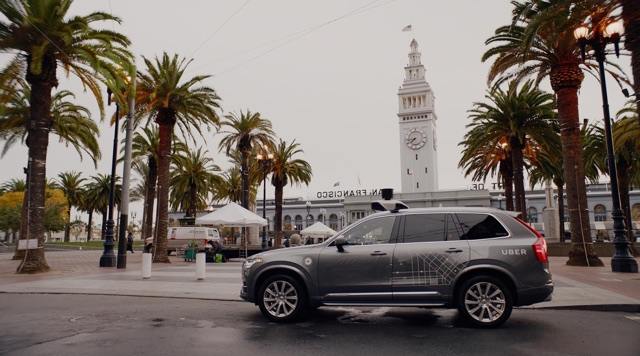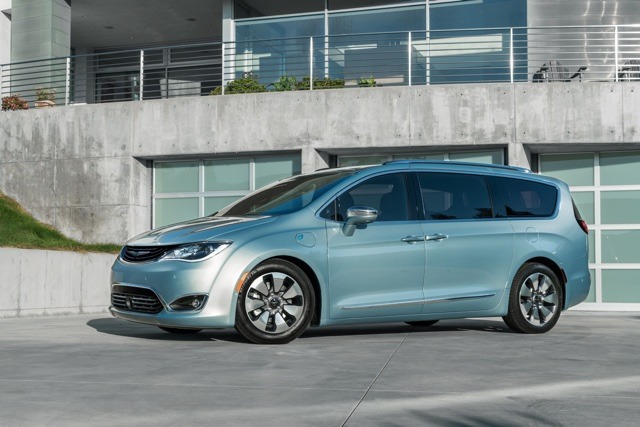Search the Community
Showing results for tags 'self-driving'.
-
For the past couple of years, Tesla has been offering an $8,000 "full self-driving" feature for their Autopilot system. But you couldn't use this feature as Tesla had not yet activated this feature. Basically, you were buying a system that Tesla promised would come online sometime in the near future. But that is not happening as Tesla has pulled the option for the time being. Last night, Tesla CEO Elon Musk tweeted the option has been taken off due to it causing "too much confusion". Since Tesla began offering the option in October 2016, the company has seen a number of top managers and engineers leave the Autopilot program. A number of owners who paid for the $8,000 option have filed a class-action lawsuit, "alleging they were deceived into buying a feature that didn’t exist." However, this feature isn't going away. Bloomberg obtained an internal email where Musk told employees they needed about 100 more people to join an internal testing program that is linked to full self-driving feature. Source: Bloomberg View full article
-
For the past couple of years, Tesla has been offering an $8,000 "full self-driving" feature for their Autopilot system. But you couldn't use this feature as Tesla had not yet activated this feature. Basically, you were buying a system that Tesla promised would come online sometime in the near future. But that is not happening as Tesla has pulled the option for the time being. Last night, Tesla CEO Elon Musk tweeted the option has been taken off due to it causing "too much confusion". Since Tesla began offering the option in October 2016, the company has seen a number of top managers and engineers leave the Autopilot program. A number of owners who paid for the $8,000 option have filed a class-action lawsuit, "alleging they were deceived into buying a feature that didn’t exist." However, this feature isn't going away. Bloomberg obtained an internal email where Musk told employees they needed about 100 more people to join an internal testing program that is linked to full self-driving feature. Source: Bloomberg
-

GM's Cruise Self-Driving Unit Faces Some Big Hurdles
William Maley posted an article in General Motors
By the end of next year, GM's self-driving car unit was planning to have a fleet of self-driving taxis available those in San Fransisco, California. But a new report from Reuters casts some serious doubts on this goal. Speaking to a number of current and former GM and Cruise Automation employees, and autonomous vehicle technology experts, Reuters' report paints a picture of various issues that could derail Cruise's goal. The driverless Cruise vehicles (Chevrolet Bolt EVs) have struggled to determine whether objects on the road are moving or stationary. Example: Vehicles have stopped or hesitated when driving past a group of parked bicycles or motorcycles. Software has failed to identify pedestrians, "and has mistakenly seen phantom bicycles, causing the cars to brake erratically" Sources claim that software also slows the messages between the car’s sensors and computers Cruise doesn't have a data-sharing collaboration with the San Francisco Fire Department - necessary to train the cars when a fire truck is responding to an emergency. Numerous milestones have been missed such as logging a million miles a month by early 2018. Cruise is aware of the various issues. CEO Kyle Vogt told Reuters said the next-generation of hardware and software would solve various issues. General Motors' President Dan Ammann said that the 2019 goal would only move forward "if the Cruise system achieves the safety standards the automaker has established, and shown to regulators." At the current moment, that goal seems quite far away. Source: Reuters- 4 comments
-
- cruise
- general motors
-
(and 3 more)
Tagged with:
-
By the end of next year, GM's self-driving car unit was planning to have a fleet of self-driving taxis available those in San Fransisco, California. But a new report from Reuters casts some serious doubts on this goal. Speaking to a number of current and former GM and Cruise Automation employees, and autonomous vehicle technology experts, Reuters' report paints a picture of various issues that could derail Cruise's goal. The driverless Cruise vehicles (Chevrolet Bolt EVs) have struggled to determine whether objects on the road are moving or stationary. Example: Vehicles have stopped or hesitated when driving past a group of parked bicycles or motorcycles. Software has failed to identify pedestrians, "and has mistakenly seen phantom bicycles, causing the cars to brake erratically" Sources claim that software also slows the messages between the car’s sensors and computers Cruise doesn't have a data-sharing collaboration with the San Francisco Fire Department - necessary to train the cars when a fire truck is responding to an emergency. Numerous milestones have been missed such as logging a million miles a month by early 2018. Cruise is aware of the various issues. CEO Kyle Vogt told Reuters said the next-generation of hardware and software would solve various issues. General Motors' President Dan Ammann said that the 2019 goal would only move forward "if the Cruise system achieves the safety standards the automaker has established, and shown to regulators." At the current moment, that goal seems quite far away. Source: Reuters View full article
- 4 replies
-
- cruise
- general motors
-
(and 3 more)
Tagged with:
-
Waymo is expanding its partnership with automakers. On the eve of the New York Auto Show, the company announced a new partnership with Jaguar Land Rover that will include rolling out a fleet of more than 20,000 self-driving, fully electric I-Pace SUVs over the course of the next two years. Waymo CEO John Krafcik describes the new addition to their fleet as being the "world’s first premium, electric, self-driving car." The I-Paces will be part of Waymo's upcoming self-driving transportation service that will launch later this year in Arizona with the Chrysler Pacifica Hybrid. Prototypes of the I-Pace with Waymo tech will launch towards the end of year. Waymo is planning on having a broader spectrum of vehicles in its autonomous fleet from small cars to semi trucks. "With the Jaguar I-PACE we have a world-beating car that’s captured the imagination of customers around the world. Our passion for further advancing smart mobility needs expert long-term partners. In joining forces with Waymo we are pioneering to push the boundaries of technology. Together we will deliver the self-driving Waymo Jaguar I-PACE with the grace, space and eco-pace that customers expect," said Jaguar Land Rover CEO Ralf Speth. This announcement comes at a very awkward time for self-driving cars. Last week, a pedestrian was killed in a collision with an Uber self-driving vehicle in Arizona. Since then, a number of companies have suspended testing on public roads. Arizona has also has suspended Uber from conducting self-driving tests in the state. Source: Jaguar Land Rover Press Release is on Page 2 WAYMO AND JAGUAR LAND ROVER ANNOUNCE LONG-TERM PARTNERSHIP, BEGINNING WITH SELF-DRIVING JAGUAR I-PACE Jaguar Land Rover and Waymo today announce a long-term strategic partnership. Together, the two companies will develop the world’s first premium self-driving electric vehicle for Waymo’s driverless transportation service. Jaguar I-PACE will be the first premium self-driving electric vehicle in Waymo’s fleet First Waymo self-driving I-PACE will start tests in 2018, and become part of Waymo’s driverless fleet from 2020 Up to 20,000 vehicles to join Waymo’s fleet in the first two years of production Jaguar Land Rover and Waymo to explore other future collaborations Jaguar Land Rover and Waymo today announce a long-term strategic partnership. Together, the two companies will develop the world’s first premium self-driving electric vehicle for Waymo’s driverless transportation service. Jaguar Land Rover and Waymo (formerly Google self-driving car project) will work together to design and engineer self-driving Jaguar I-PACE vehicles. This long-term strategic collaboration will further Waymo and Jaguar Land Rover’s shared goals: to make cars safer, free up people’s valuable time and improve mobility for everyone. Waymo Jaguar I-PACEs, equipped with Waymo's self-driving technology, will start testing later this year. On-road testing and capturing real-world data will allow Waymo and Jaguar Land Rover engineers to refine technology and deliver optimum safety and reliability. Up to 20,000 I-PACEs will be built in the first two years of production and be available for riders of Waymo’s driverless service, serving a potential one million trips per day. The Jaguar I-PACE was launched earlier this month and is the company’s first full-electric SUV. It is all-new from the ground up and is a no compromise, desirable and practical electric performance car. Jaguar Land Rover is committed to investing heavily, becoming automotive leaders in autonomous, connected and future electrified technologies. To date, Waymo is the only company with a fleet of fully self-driving cars — with no one in the front seat — on public roads. Later this year Waymo will launch the world’s first self-driving transportation service allowing members of the public to use Waymo’s app to request a vehicle. "With the Jaguar I-PACE we have a world-beating car that’s captured the imagination of customers around the world. Our passion for further advancing smart mobility needs expert long-term partners. In joining forces with Waymo we are pioneering to push the boundaries of technology. Together we will deliver the self-driving Waymo Jaguar I-PACE with the grace, space and eco-pace that customers expect." PROF. DR. RALF SPETH JAGUAR LAND ROVER CHIEF EXECUTIVE OFFICER "While we've been focused at Waymo on building the world's most experienced driver, the team at Jaguar Land Rover has developed an all-new battery-electric platform that looks to set a new standard in safety, design and capability. We're sure Waymo riders will enjoy the safe, premium and delightful experience that the self-driving I-PACE will provide." JOHN KRAFCIK WAYMO CHIEF EXECUTIVE OFFICER View full article
-
Waymo is expanding its partnership with automakers. On the eve of the New York Auto Show, the company announced a new partnership with Jaguar Land Rover that will include rolling out a fleet of more than 20,000 self-driving, fully electric I-Pace SUVs over the course of the next two years. Waymo CEO John Krafcik describes the new addition to their fleet as being the "world’s first premium, electric, self-driving car." The I-Paces will be part of Waymo's upcoming self-driving transportation service that will launch later this year in Arizona with the Chrysler Pacifica Hybrid. Prototypes of the I-Pace with Waymo tech will launch towards the end of year. Waymo is planning on having a broader spectrum of vehicles in its autonomous fleet from small cars to semi trucks. "With the Jaguar I-PACE we have a world-beating car that’s captured the imagination of customers around the world. Our passion for further advancing smart mobility needs expert long-term partners. In joining forces with Waymo we are pioneering to push the boundaries of technology. Together we will deliver the self-driving Waymo Jaguar I-PACE with the grace, space and eco-pace that customers expect," said Jaguar Land Rover CEO Ralf Speth. This announcement comes at a very awkward time for self-driving cars. Last week, a pedestrian was killed in a collision with an Uber self-driving vehicle in Arizona. Since then, a number of companies have suspended testing on public roads. Arizona has also has suspended Uber from conducting self-driving tests in the state. Source: Jaguar Land Rover Press Release is on Page 2 WAYMO AND JAGUAR LAND ROVER ANNOUNCE LONG-TERM PARTNERSHIP, BEGINNING WITH SELF-DRIVING JAGUAR I-PACE Jaguar Land Rover and Waymo today announce a long-term strategic partnership. Together, the two companies will develop the world’s first premium self-driving electric vehicle for Waymo’s driverless transportation service. Jaguar I-PACE will be the first premium self-driving electric vehicle in Waymo’s fleet First Waymo self-driving I-PACE will start tests in 2018, and become part of Waymo’s driverless fleet from 2020 Up to 20,000 vehicles to join Waymo’s fleet in the first two years of production Jaguar Land Rover and Waymo to explore other future collaborations Jaguar Land Rover and Waymo today announce a long-term strategic partnership. Together, the two companies will develop the world’s first premium self-driving electric vehicle for Waymo’s driverless transportation service. Jaguar Land Rover and Waymo (formerly Google self-driving car project) will work together to design and engineer self-driving Jaguar I-PACE vehicles. This long-term strategic collaboration will further Waymo and Jaguar Land Rover’s shared goals: to make cars safer, free up people’s valuable time and improve mobility for everyone. Waymo Jaguar I-PACEs, equipped with Waymo's self-driving technology, will start testing later this year. On-road testing and capturing real-world data will allow Waymo and Jaguar Land Rover engineers to refine technology and deliver optimum safety and reliability. Up to 20,000 I-PACEs will be built in the first two years of production and be available for riders of Waymo’s driverless service, serving a potential one million trips per day. The Jaguar I-PACE was launched earlier this month and is the company’s first full-electric SUV. It is all-new from the ground up and is a no compromise, desirable and practical electric performance car. Jaguar Land Rover is committed to investing heavily, becoming automotive leaders in autonomous, connected and future electrified technologies. To date, Waymo is the only company with a fleet of fully self-driving cars — with no one in the front seat — on public roads. Later this year Waymo will launch the world’s first self-driving transportation service allowing members of the public to use Waymo’s app to request a vehicle. "With the Jaguar I-PACE we have a world-beating car that’s captured the imagination of customers around the world. Our passion for further advancing smart mobility needs expert long-term partners. In joining forces with Waymo we are pioneering to push the boundaries of technology. Together we will deliver the self-driving Waymo Jaguar I-PACE with the grace, space and eco-pace that customers expect." PROF. DR. RALF SPETH JAGUAR LAND ROVER CHIEF EXECUTIVE OFFICER "While we've been focused at Waymo on building the world's most experienced driver, the team at Jaguar Land Rover has developed an all-new battery-electric platform that looks to set a new standard in safety, design and capability. We're sure Waymo riders will enjoy the safe, premium and delightful experience that the self-driving I-PACE will provide." JOHN KRAFCIK WAYMO CHIEF EXECUTIVE OFFICER
-
Volvo an Uber announced a deal where Uber will purchase 24,000 Volvo XC90 Plug-In Hybrid SUVs over 3 years to expand Uber's self-driving fleet. Uber has been testing self-driving vehicles in Pittsburgh since Autumn 2016 with human supervision in the driver seat. Over 100 such vehicles are currently in operation in the city. The deal marks the largest single order of vehicles for Geely owned Volvo. While no financial details were disclosed, the minimum retail price for an XC90 T8 Hybrid is $64,950. Volvo expects the profit margin per vehicle to be on par with traditional sales through a dealership network. Uber chose the XC90 because much of the hardware to add autonomous capabilities is already built into the car. Geely/Volvo engineers have been working closely with Uber to ensure that compatibility going forward. With a major shift in buying and driving habits coming in the future, Volvo is placing its chips on partnering with Uber to remain relevant in an industry ripe for disruption. Photo: Uber View full article
- 1 reply
-
- autonomous
- self-driving
-
(and 3 more)
Tagged with:
-
Volvo an Uber announced a deal where Uber will purchase 24,000 Volvo XC90 Plug-In Hybrid SUVs over 3 years to expand Uber's self-driving fleet. Uber has been testing self-driving vehicles in Pittsburgh since Autumn 2016 with human supervision in the driver seat. Over 100 such vehicles are currently in operation in the city. The deal marks the largest single order of vehicles for Geely owned Volvo. While no financial details were disclosed, the minimum retail price for an XC90 T8 Hybrid is $64,950. Volvo expects the profit margin per vehicle to be on par with traditional sales through a dealership network. Uber chose the XC90 because much of the hardware to add autonomous capabilities is already built into the car. Geely/Volvo engineers have been working closely with Uber to ensure that compatibility going forward. With a major shift in buying and driving habits coming in the future, Volvo is placing its chips on partnering with Uber to remain relevant in an industry ripe for disruption. Photo: Uber
- 1 comment
-
- autonomous
- self-driving
-
(and 3 more)
Tagged with:
-
A self-driving shuttle service got off to an auspicious start yesterday in Las Vegas when it was involved in an accident with a delivery truck. According to NBC affiliate KSNV, the accident took place during the shuttle's first hour of service when a delivery truck back into the shuttle. According to an AAA representative on Twitter, the driver was cited by Las Vegas Metro Police. "The autonomous shuttle was testing today when it was grazed by a delivery truck downtown. The shuttle did what it was supposed to do, in that it’s sensors registered the truck and the shuttle stopped to avoid the accident. Unfortunately, the delivery truck did not stop and grazed the front fender of the shuttle. Had the truck had the same sensing equipment that the shuttle has the accident would have been avoided," a representative of the City of Las Vegas said in a statement. The shuttle in question comes from Navya, a French company that specializes in self-driving technology. It features lidar, radar, and video cameras around the vehicle and is powered by an electric motor. The shuttle is part of a year-long study by Navya, AAA, shuttle operator Keolis North America, City of Las Vegas, and the Regional Transportation Commission of Southern Nevada to see how the shuttle fares on public roads and whether or not riders are accepting of it. Source: KSNV, Car and Driver, (2) Pic Credit: KSNV
- 6 comments
-
- accident
- self-driving
-
(and 1 more)
Tagged with:
-
A self-driving shuttle service got off to an auspicious start yesterday in Las Vegas when it was involved in an accident with a delivery truck. According to NBC affiliate KSNV, the accident took place during the shuttle's first hour of service when a delivery truck back into the shuttle. According to an AAA representative on Twitter, the driver was cited by Las Vegas Metro Police. "The autonomous shuttle was testing today when it was grazed by a delivery truck downtown. The shuttle did what it was supposed to do, in that it’s sensors registered the truck and the shuttle stopped to avoid the accident. Unfortunately, the delivery truck did not stop and grazed the front fender of the shuttle. Had the truck had the same sensing equipment that the shuttle has the accident would have been avoided," a representative of the City of Las Vegas said in a statement. The shuttle in question comes from Navya, a French company that specializes in self-driving technology. It features lidar, radar, and video cameras around the vehicle and is powered by an electric motor. The shuttle is part of a year-long study by Navya, AAA, shuttle operator Keolis North America, City of Las Vegas, and the Regional Transportation Commission of Southern Nevada to see how the shuttle fares on public roads and whether or not riders are accepting of it. Source: KSNV, Car and Driver, (2) Pic Credit: KSNV View full article
- 6 replies
-
- 1
-

-
- accident
- self-driving
-
(and 1 more)
Tagged with:
-
Towards the end of Obama presidency, the administration unveiled guidelines for testing and deployment of self-driving cars in the US. But there is a new presidency in the White House and that means things will be changing - although details are scarce as to how. U.S. Transportation Secretary Elaine Chao said in Detroit yesterday the Department of Transportation would revisit and revise the guidelines put forth by the previous administration within the next few months. "The pressure is mounting for the federal government to do something" about autonomous vehicles, said Chao. "We don't want rules that impede future technological advances." Chao didn't go into details about the changes that would be made or how it would differ from those made under the Obama presidency. The current guidelines introduced last fall includes a 15-point assessment that automakers would use to determine whether an autonomous vehicle was ready to go on the road or not. The assessment includes such items as privacy and validation methods. Automakers have voiced concerns on the guidelines, saying it would delay the testing by months and requires them to hand over data. Source: Reuters View full article
- 2 replies
-
- department of transportation
- dot
- (and 3 more)
-

Trump Administration To Revisit Self-Driving Guidelines
William Maley posted an article in Automotive Industry
Towards the end of Obama presidency, the administration unveiled guidelines for testing and deployment of self-driving cars in the US. But there is a new presidency in the White House and that means things will be changing - although details are scarce as to how. U.S. Transportation Secretary Elaine Chao said in Detroit yesterday the Department of Transportation would revisit and revise the guidelines put forth by the previous administration within the next few months. "The pressure is mounting for the federal government to do something" about autonomous vehicles, said Chao. "We don't want rules that impede future technological advances." Chao didn't go into details about the changes that would be made or how it would differ from those made under the Obama presidency. The current guidelines introduced last fall includes a 15-point assessment that automakers would use to determine whether an autonomous vehicle was ready to go on the road or not. The assessment includes such items as privacy and validation methods. Automakers have voiced concerns on the guidelines, saying it would delay the testing by months and requires them to hand over data. Source: Reuters- 2 comments
-
- department of transportation
- dot
- (and 3 more)
-
Before the Consumer Electronics Show kicks off in Las Vegas next week, Ford has unveiled the second-generation self-driving Fusion Hybrid test vehicle. The most noticeable change is cosmetic. Gone are the tall cylinder sensors mounted on the roof. In their place are a set of roof rails featuring new LiDAR sensors that give the vehicle a more targeted field of vision. This allows Ford to only use two sensors which provide the same amount of data if they were using four. Other improvements over the previous test vehicle include more computational and electrical power; computer vision and machine learning technologies; and highly-detailed 3D maps. "The Virtual Driver's responsibilities can be slotted into three tasks: sensing the surrounding environment, using that perception to make decisions on the road, and controlling the car. The Fusion Hybrid's autonomous brain is located in the trunk, where the equivalent of several high-end computers generate 1 terabyte of data an hour - more than the average person would use in mobile phone data in 45 years," wrote chief program engineer Chris Brewer in a post on Medium. These improvements plus an expansion of their test fleet to 90 vehicles should help Ford reach its goal of having a Level 4 autonomous vehicle - designed to perform safety-critical driving functions and monitor conditions during the trip - by 2021. Source: Ford, Medium Press Release is on Page 2 FORD DEBUTS NEXT-GENERATION FUSION HYBRID AUTONOMOUS DEVELOPMENT VEHICLE; CAR TO FIRST APPEAR AT CES AND NORTH AMERICAN INTERNATIONAL AUTO SHOW IN JANUARY Ford Motor Company is introducing its next-generation Fusion Hybrid autonomous development vehicle, just in time for CES and the North American International Auto Show in January. The new vehicle uses the current Ford autonomous vehicle platform, but ups the processing power with new computer hardware. Electrical controls are closer to production-ready, and adjustments to the sensor technology, including placement, allow the car to better see what’s around it. New LiDAR sensors have a sleeker design and more targeted field of vision, which enables the car to now use just two sensors rather than four, while still getting just as much data. The new vehicle also evolves the two main elements to creating an autonomous vehicle – the autonomous vehicle platform, which is an upgraded version of the car itself, and the virtual driver system. The next-gen Fusion Hybrid autonomous development vehicle follows the company’s current generation, which hit the streets three years ago. View full article
-
Before the Consumer Electronics Show kicks off in Las Vegas next week, Ford has unveiled the second-generation self-driving Fusion Hybrid test vehicle. The most noticeable change is cosmetic. Gone are the tall cylinder sensors mounted on the roof. In their place are a set of roof rails featuring new LiDAR sensors that give the vehicle a more targeted field of vision. This allows Ford to only use two sensors which provide the same amount of data if they were using four. Other improvements over the previous test vehicle include more computational and electrical power; computer vision and machine learning technologies; and highly-detailed 3D maps. "The Virtual Driver's responsibilities can be slotted into three tasks: sensing the surrounding environment, using that perception to make decisions on the road, and controlling the car. The Fusion Hybrid's autonomous brain is located in the trunk, where the equivalent of several high-end computers generate 1 terabyte of data an hour - more than the average person would use in mobile phone data in 45 years," wrote chief program engineer Chris Brewer in a post on Medium. These improvements plus an expansion of their test fleet to 90 vehicles should help Ford reach its goal of having a Level 4 autonomous vehicle - designed to perform safety-critical driving functions and monitor conditions during the trip - by 2021. Source: Ford, Medium Press Release is on Page 2 FORD DEBUTS NEXT-GENERATION FUSION HYBRID AUTONOMOUS DEVELOPMENT VEHICLE; CAR TO FIRST APPEAR AT CES AND NORTH AMERICAN INTERNATIONAL AUTO SHOW IN JANUARY Ford Motor Company is introducing its next-generation Fusion Hybrid autonomous development vehicle, just in time for CES and the North American International Auto Show in January. The new vehicle uses the current Ford autonomous vehicle platform, but ups the processing power with new computer hardware. Electrical controls are closer to production-ready, and adjustments to the sensor technology, including placement, allow the car to better see what’s around it. New LiDAR sensors have a sleeker design and more targeted field of vision, which enables the car to now use just two sensors rather than four, while still getting just as much data. The new vehicle also evolves the two main elements to creating an autonomous vehicle – the autonomous vehicle platform, which is an upgraded version of the car itself, and the virtual driver system. The next-gen Fusion Hybrid autonomous development vehicle follows the company’s current generation, which hit the streets three years ago.
-

This Is What A Driverless Pacifica Plug-In Hybrid Looks Like
William Maley posted an article in Chrysler
Back in May, Google and Fiat Chrysler Automobiles made a startling announcement. The two would partner on building 100 specially prepared Chrysler Pacifica plug-in hybrid minivans with Google's autonomous driving technologies to be used for testing. Today, Waymo (the offshoot of Google's self-driving program) and FCA revealed what the van would look like. Yes, the van looks a little bit goofy with sensors sticking out on the front fenders and under the grille, along with massive radar dome. Other changes include major modifications to the chassis, electrical system, powertrain, and structure. Considering this took around six months, it is quite the achievement. “The Pacifica Hybrid will be a great addition to our fully self-driving test fleet. FCA’s product development and manufacturing teams have been agile partners, enabling us to go from program kickoff to full vehicle assembly in just six months. They've been great partners, and we look forward to continued teamwork with them as we move into 2017,” said John Krafcik, Chief Executive Officer of Waymo in a statement. The vans will join Waymo's test fleet early next year. Source: Fiat Chrysler Automobiles Press Release is on Page 2 CA Delivers 100 Uniquely Built Chrysler Pacifica Hybrid Minivans to Waymo for Self-driving Test Fleet Waymo and FCA reveal first look at fully self-driving Chrysler Pacifica Hybrid minivan Program kickoff to full vehicle assembly completed by technical teams in six months December 19, 2016 , Auburn Hills, Mich. - Waymo (formerly the Google self-driving car project) and FCA announced today that production of 100 Chrysler Pacifica Hybrid minivans uniquely built to enable fully self-driving operations has been completed. The vehicles are currently being outfitted with Waymo’s fully self-driving technology, including a purpose-built computer and a suite of sensors, telematics and other systems, and will join Waymo’s self-driving test fleet in early 2017. Waymo and FCA also revealed today the first images of the fully self-driving Chrysler Pacifica Hybrid vehicle. This first-of-its kind collaboration brought engineers from FCA and Waymo together to integrate Waymo’s fully self-driving system into the all-new 2017 Chrysler Pacifica Hybrid minivan thereby leveraging each company’s individual strengths and resources. Engineering modifications to the minivan’s electrical, powertrain, chassis and structural systems were implemented to optimize the Pacifica Hybrid for Waymo’s fully self-driving technology. “The Pacifica Hybrid will be a great addition to our fully self-driving test fleet. FCA’s product development and manufacturing teams have been agile partners, enabling us to go from program kickoff to full vehicle assembly in just six months,” said John Krafcik, Chief Executive Officer, Waymo. “They've been great partners, and we look forward to continued teamwork with them as we move into 2017.” Waymo and FCA co-located part of their engineering teams at a facility in southeastern Michigan to accelerate the overall development process. In addition, extensive testing was carried out at FCA’s Chelsea Proving Grounds in Chelsea, Michigan, and Arizona Proving Grounds in Yucca, Arizona, as well as Waymo test sites in California. “As consumers’ transportation needs evolve, strategic collaborations such as this one are vital to promoting a culture of innovation, safety and technology,” said Sergio Marchionne, Chief Executive Officer, FCA. “Our partnership with Waymo enables FCA to directly address the opportunities and challenges the automotive industry faces as we quickly approach a future where fully self-driving vehicles are very much a part of our daily lives.” Self-driving cars have the potential to prevent some of the 1.2 million deaths that occur each year on roads worldwide, 94 percent of which are caused by human error. This collaboration will help FCA and Waymo better understand what it will take to bring self-driving cars into the world.-
- autonomous
- chrysler
- (and 7 more)
-
There is a right way and a wrong way when it comes to testing autonomous vehicles on public roads. Uber has demonstrated the wrong way. Yesterday, the company launched eleven driverless Volvo XC90s in San Fransisco as part of a pilot program. But by late morning, two of the eleven vehicles were running amok. The San Fransisco Examiner got their hands on a dash cam video showing one of the XC90s running a red light at 10:37 A.M. Later that morning, a freelance producer and writer tweeted “Just passed a ‘self-driving’ Uber that lurched into the intersection on Van Ness [Avenue], on a red, nearly hitting my Lyft.” “It was close enough that both myself and the driver reacted and were like, ‘Shit. It stopped suddenly and stayed like that, as you see in the photo,” said Annie Gaus to the Examiner. Because of these incidents, the California Department of Motor Vehicles ordered Uber to halt the program. In a statement obtained by The Truth About Cars, Uber said the incident on video was due to human error and not the technology. “This incident was due to human error. This is why we believe so much in making the roads safer by building self-driving Ubers. This vehicle was not part of the pilot and was not carrying customers. The driver involved has been suspended while we continue to investigate.” Not the most reassuring statement considering said vehicle looks like one from the pilot program. At the moment, Uber has drivers in the self-driving vehicles to control them in case of an issue. But there is a bigger problem at hand. Uber did not have the permit to legally have their autonomous vehicles on the road. A press release on Uber's Newsroom announcing the program said they didn't need one. Here are the paragraphs in question, "Finally, we understand that there is a debate over whether or not we need a testing permit to launch self-driving Ubers in San Francisco. We have looked at this issue carefully and we don’t believe we do. Before you think, “there they go again” let us take a moment to explain: First, we are not planning to operate any differently than in Pittsburgh, where our pilot has been running successfully for several months. Second, the rules apply to cars that can drive without someone controlling or monitoring them. For us, it’s still early days and our cars are not yet ready to drive without a person monitoring them." Unsurprisingly, the California DMV is not happy with Uber and threaten legal action if Uber did not halt the program and obtain the permit. “If Uber does not confirm immediately that it will stop its launch and seek a testing permit, the DMV will initiate legal action,” wrote DMV attorney Brian Soublet in a letter sent Anthony Levandowski, who heads Uber’s autonomous car program. This isn't the first time Uber's autonomous program has found itself in hot water. Back in September, Quartz reported on the issues Uber was having with their autonomous program in Pittsburgh from a vehicle going the wrong way down a one-way street to a minor accident. Source: San Francisco Examiner , (2), The Truth About Cars , Quartz, Uber Newsroom Pic Credit: Uber View full article
- 1 reply
-
- autonomous vehicle
- halt
-
(and 4 more)
Tagged with:
-
There is a right way and a wrong way when it comes to testing autonomous vehicles on public roads. Uber has demonstrated the wrong way. Yesterday, the company launched eleven driverless Volvo XC90s in San Fransisco as part of a pilot program. But by late morning, two of the eleven vehicles were running amok. The San Fransisco Examiner got their hands on a dash cam video showing one of the XC90s running a red light at 10:37 A.M. Later that morning, a freelance producer and writer tweeted “Just passed a ‘self-driving’ Uber that lurched into the intersection on Van Ness [Avenue], on a red, nearly hitting my Lyft.” “It was close enough that both myself and the driver reacted and were like, ‘Shit. It stopped suddenly and stayed like that, as you see in the photo,” said Annie Gaus to the Examiner. Because of these incidents, the California Department of Motor Vehicles ordered Uber to halt the program. In a statement obtained by The Truth About Cars, Uber said the incident on video was due to human error and not the technology. “This incident was due to human error. This is why we believe so much in making the roads safer by building self-driving Ubers. This vehicle was not part of the pilot and was not carrying customers. The driver involved has been suspended while we continue to investigate.” Not the most reassuring statement considering said vehicle looks like one from the pilot program. At the moment, Uber has drivers in the self-driving vehicles to control them in case of an issue. But there is a bigger problem at hand. Uber did not have the permit to legally have their autonomous vehicles on the road. A press release on Uber's Newsroom announcing the program said they didn't need one. Here are the paragraphs in question, "Finally, we understand that there is a debate over whether or not we need a testing permit to launch self-driving Ubers in San Francisco. We have looked at this issue carefully and we don’t believe we do. Before you think, “there they go again” let us take a moment to explain: First, we are not planning to operate any differently than in Pittsburgh, where our pilot has been running successfully for several months. Second, the rules apply to cars that can drive without someone controlling or monitoring them. For us, it’s still early days and our cars are not yet ready to drive without a person monitoring them." Unsurprisingly, the California DMV is not happy with Uber and threaten legal action if Uber did not halt the program and obtain the permit. “If Uber does not confirm immediately that it will stop its launch and seek a testing permit, the DMV will initiate legal action,” wrote DMV attorney Brian Soublet in a letter sent Anthony Levandowski, who heads Uber’s autonomous car program. This isn't the first time Uber's autonomous program has found itself in hot water. Back in September, Quartz reported on the issues Uber was having with their autonomous program in Pittsburgh from a vehicle going the wrong way down a one-way street to a minor accident. Source: San Francisco Examiner , (2), The Truth About Cars , Quartz, Uber Newsroom Pic Credit: Uber
- 1 comment
-
- autonomous vehicle
- halt
-
(and 4 more)
Tagged with:
-
Alphabet Inc. - Google's parent company - wants to find automotive partners to use their autonomous technologies. Fiat Chrysler Automobiles is looking for partners to help offset costs of development and production. In fact, CEO Sergio Marchionne has hinted that he is open to working with a technology company. Chocolate, meet peanut butter. The Wall Street Journal has learned from a source that Alphabet and FCA are in the late stages of talks about a technology partnership. These talks have been ongoing for a few months explained the source. But why Fiat Chrysler Automobiles? Compared to other automakers, they are way behind in a number of key technology areas. The AutoExtremist, who first reported the rumor, explained FCA has a couple key items that interest Alphabet Inc. First is the upcoming Pacifica minivan which could be developed into a fully autonomous vehicle. The second is that FCA has the manufacturing capability and dealer network, something Alphabet lacks. Source: The AutoExtremist, The Wall Street Journal View full article
- 2 replies
-
- Alphabet Inc.
- FCA
-
(and 6 more)
Tagged with:
-
Alphabet Inc. - Google's parent company - wants to find automotive partners to use their autonomous technologies. Fiat Chrysler Automobiles is looking for partners to help offset costs of development and production. In fact, CEO Sergio Marchionne has hinted that he is open to working with a technology company. Chocolate, meet peanut butter. The Wall Street Journal has learned from a source that Alphabet and FCA are in the late stages of talks about a technology partnership. These talks have been ongoing for a few months explained the source. But why Fiat Chrysler Automobiles? Compared to other automakers, they are way behind in a number of key technology areas. The AutoExtremist, who first reported the rumor, explained FCA has a couple key items that interest Alphabet Inc. First is the upcoming Pacifica minivan which could be developed into a fully autonomous vehicle. The second is that FCA has the manufacturing capability and dealer network, something Alphabet lacks. Source: The AutoExtremist, The Wall Street Journal
- 2 comments
-
- Alphabet Inc.
- FCA
-
(and 6 more)
Tagged with:


